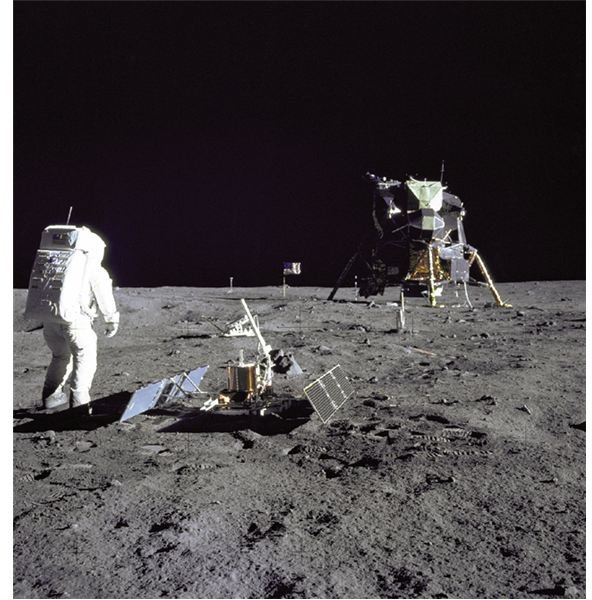NASA Facts, Achievements, Discoveries, and Goals for the Future
The Facts
1. Year established: 1958.
2. Headquarters: Washington, D.C.
3. Annual budget: $17.6 billion for fiscal year 2009 (that’s 0.57 percent of the federal government’s $3.1 trillion budget).
4. Number of employees: 18,758 civil service employees, another 40,000 contractors and grantees
5. Mission: To “pioneer the future in space exploration, scientific discovery and aeronautics research.”
6. Mission directorates: Aeronautics, Exploration Systems, Science, Space Operations.
7. Number of field centers: 10 (Ames Research Center, Dryden Flight Research Center, Glenn Research Center, Goddard Space Flight Center, Jet Propulsion Laboratory, Johnson Space Center, Kennedy Space Center, Langley Research Center, Marshall Space Flight Center, Stennis Space Center)
8. Other facilities: Goddard Institute for Space Studies, Independent Verification and Validation Facility, NASA Shared Service Center, Wallops Flight Facility.
9. Major achievements:
- First manned moon landing (Apollo 11, July 20, 1969)
- First planetary flyby (Mariner 2, which flew past Venus in 1962)
- First spacecraft to orbit another planet (Mariner 9, which orbited Mars in 1971-72)
- First images sent from another planet (Mariner 9, which sent back photos of the surface of Mars in 1971-72)
- First spacecraft to travel through the asteroid belt (Pioneer 10, launched in 1972 to study Jupiter)
- First reusable spacecraft (Space Shuttle, first launched in 1981)
- First major optical telescope in space (Hubble, launched in 1990)
- First mission to create an intentional impact on a comet’s surface (Deep Impact, 2005)
- First returned sample of cosmic dust (Stardust, 2006)
- First spacecraft expected to study Pluto (New Horizons, set to arrive at Pluto in 2015).
10. Number of patents: More than 6,300.
11. Innovations:
- Ultra-thin, reflective thermal insulation blankets;
- Software for diagnosing heart disease;
- Toothpaste that’s safe to digest;
- “Memory foam”;
- Lightweight and aerodynamic helmets for sports;
- Freeze-dried foods;
- Solar cells;
- Scratch-resistant eyeglasses;
- But not Tang, Teflon or Velcro.
12. Other research programs: Earth Observing System (to measure global climate change), Lightning Imaging Sensor (weather research and forecasting), Seasat (ocean research satellite), aeronautics research
13. Highest honor awarded: Congressional Space Medal of Honor, given to any astronaut who “distinguished himself by exceptionally meritorious efforts and contributions to the welfare of the nation and of mankind.”
14. Number of Congressional Space Medal of Honor awardees: 28 (including all members of the Challenger and Columbia space shuttles)
15. Recent discoveries:
- Falling snow on Mars (Phoenix Mars Lander, September 2008);
- Solar wind at an all-time recorded low (Ulysses, September 2008);
- Confirmed water on Mars (Phoenix, July 2008);
- Confirmed liquid lake on Titan, a moon of Saturn (Cassini, July 2008).
16. Future goals: Vision for Space Exploration, announced in 2004, calls for:
-
A manned return to the moon by 2020;
-
A next-generation reusable spacecraft to replace the soon-to-retire Space Shuttle;
-
A possible manned mission to Mars.

Top left: Astronaut Buzz Aldrin looks over Tranquility Base during NASA’s historic moon landing in 1969. (Image credit: NASA, https://grin.hq.nasa.gov/IMAGES/SMALL/GPN-2000-001102.jpg)
Right: An image of two spiral galaxies in a close encounter, taken by the Hubble Space Telescope. (Image credit: NASA, https://grin.hq.nasa.gov/IMAGES/SMALL/GPN-2000-000897.jpg)
More Fascinating Facts About NASA

1. A boost for wind energy. Data from NASA’s QuikSCAT satellite could help scientists map out parts of the oceans best suited for offshore wind-energy farms. Launched in 1999, QuikSCAT measures wind directions and speeds near ocean surfaces.
2. Virtual tours anytime. NASA’s interactive Web-based feature to mark the agency’s 50th anniversary this year includes excerpts from the late astronomer Carl Sagan’s popular TV show, “Cosmos”; three-dimensional views of the interior of Friendship 7, the first U.S. spacecraft to orbit the Earth; and a virtual tour of the International Space Station.
3. Cash prizes for savvy inventors. NASA’s Centennial Challenges prize programs encourage inventors, students and businesses to develop “innovative solutions to technical challenges through competition and cooperation.” Past winners include Peter Homer, a Maine engineer who came up with an improved design for astronaut gloves and has since gone on to establish a company that manufactures such gloves.
Top left: Artist Alan Chinchar’s rendering of Space Station Freedom, which was never developed, with a focus instead going on construction of the International Space Station. (Image credit: NASA, https://grin.hq.nasa.gov/IMAGES/SMALL/GPN-2003-00092.jpg)
